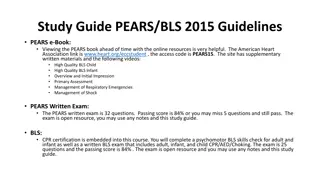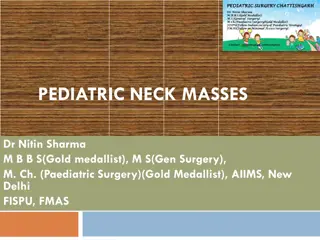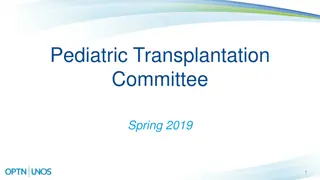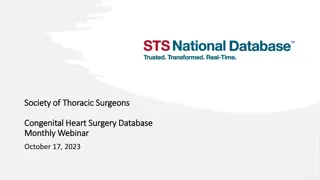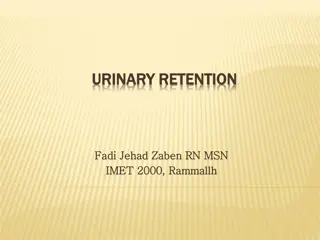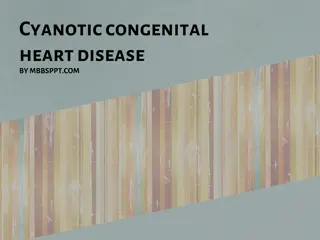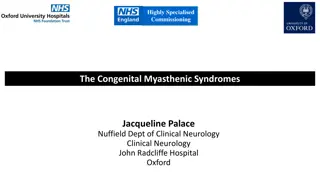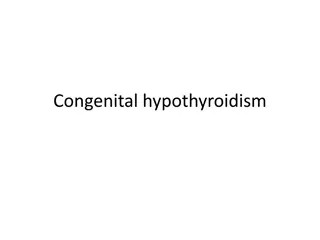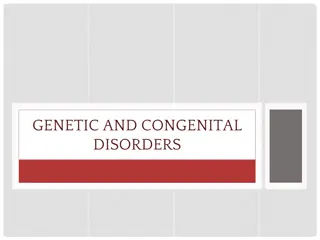Congenital Pediatric Urinary Disorders
This content delves into congenital urinary disorders in children, covering anomalies of the upper and lower urinary tracts, focusing on kidney and ureter abnormalities like renal agenesis. Details on diagnosis, management, and associated anomalies are discussed.
Uploaded on Feb 25, 2025 | 0 Views
Download Presentation

Please find below an Image/Link to download the presentation.
The content on the website is provided AS IS for your information and personal use only. It may not be sold, licensed, or shared on other websites without obtaining consent from the author.If you encounter any issues during the download, it is possible that the publisher has removed the file from their server.
You are allowed to download the files provided on this website for personal or commercial use, subject to the condition that they are used lawfully. All files are the property of their respective owners.
The content on the website is provided AS IS for your information and personal use only. It may not be sold, licensed, or shared on other websites without obtaining consent from the author.
E N D
Presentation Transcript
Congenital Pediatric Urinary Disorders Dr. HamdanALHAZMI Associated Professor and Consultant PediatricUrologist drhamdan@ksu.edu.sa
LearningObjectives: Identify the common congenitalanomalies. How to detect this anomaly on radiologicalinvestigations. Important steps in management.
Congenital UrinaryDisorders Anomalies of the Upper UrinaryTract Kidney Ureter Anomalies of the Lower UrinaryTract Urinary Bladder Urethra
Anomalies of thekidney Anomaliesof: Number Ascent Form and Fusion Rotation
1- Unilateral RenalAgenesis 1 in 1100births. Male: Female of 1.8 : 1 The left side is absentmore frequently . The ipsilateral ureteris completely absent in 50%.
Unilateral RenalAgenesis. Associatedanomalies: Anomalies of other organ systems are found frequently in affected individuals CVS,GIT,MSC M llerian ductabnormalities 25% to 50% of females 10% to 15% of males Approximatelyonefourth to onethird of women with Mullerian duct anomalies are found to haveURA.
Unilateral RenalAgenesis Presentation PrenatalUS Incidentally AbdominalUS AbdominalCT
Unilateral RenalAgenesis Diagnosis Confirmed Nuclear study(DMSA)
Bilateral RenalAgenesis Ureters are almost always absent. Bladder is either absent or hypoplastic. Adrenal glands are usually positionednormally. M llerian duct anomalies are commonlyobserved.
Bilateral RenalAgenesis Prognosis 40% are stillborn. Do not survive beyond 48 hours due to respiratory distress with hypoplasia. associated pulmonary
3- SupernumeraryKidney Definitive accessory organ with its own collecting system, blood supply, and distinct encapsulated parenchyma. Either completely separate or loosely attached to the kidneyon the ipsilateral side. The ureteral inter-relationshipson the side of the supernumerary kidney can be variable.
4- Simple RenalEctopia Left more than the right. 1 of 2100 to 3000autopsies. Most ectopic kidneysare clinicallyasymptomatic.
4- Simple RenalEctopia AssociatedAnomalies: 50% have a hydronephrosis: Obstruction: UPJO and UVJO Reflux (VUR): gradeIII or greater Malrotation Genital anomalies in the patient with ectopia isabout 15%.
5- Crossed RenalEctopia Crossed ectopia: kidney is located on the side opposite from that in which its ureter insertsinto the bladder. The ureter from each kidney is usuallyorthotopic.
Crossed RenalEctopia withFusion withoutFusion 90% are fused the superior pole of the ectopic kidney usuallyjoins with the inferior aspect of the normalkidney.
6- HorseshoeKidney The isthmus is bulky and consists of parenchymatous tissue.
HorseshoeKidney Occurs 1 in 400 persons. The calyces: normal in number atypical in orientation. pelvis remains in the vertical or obliquely lateralplane Horseshoe kidney is frequently found in association with othercongenital anomalies. UPJ obstruction in one third. 60 % asymptomatic.
7- Anomalies ofRotation The kidney and renal pelvis normally rotate 90 degrees ventromedially duringascent the calyces point laterally. the pelvis faces medially. When this alignment is notexact, the condition is known as malrotation. Frequently associated withTurner syndrome.
UPJ Presentation: PrenatalUS Incidental inNeonates/Children Symptomatic: UTI Pain Mass Hematuria Stone
UPJ O Dynamicrenogram
UPJ O DismemberedPyeloplasty
9-Ureterovesical junction (UVJ) obstruction (Megaureters)
11-EctopicUreter An ectopic ureter is anyureter, single or duplex, that doesn't enter the trigonal area of the bladder.
EctopicUreter In females the ectopic ureter may enter anywhere from the bladder neck to the perineum and the vagina, uterus,and rectum. One of the classic symptomsis continuous wetting. into even
EctopicUreter In males the ectopic ureteralways enters the urogenital system above the external sphincter or pelvic floor, and usually into the wolffian structures including vas deferens, seminal vesicles, or ejaculatory duct.
12-Ureterocele A cystic dilation of thedistal aspect of the ureter Located either within the bladder or spanning the bladder neck and urethra. Presentation: Antenatal(U/S) Urineretention Infection Calculusformation
Vesicoureteral Reflux(VUR) Normal anti-reflux mechanism Flapvalve 1. Oblique course as it entersthe bladder. 2. Proper muscularattachments to providefixation. 3. Posterior support to enableits occlusion. 4. Adequate submucosallength.
VUR Presentation Asymptomatic Prenatal Fluctuateddilatation FebrileUTIs
VUR Diagnosis: MCUG(VCUG)
VUR Management: Prophylacticantibiotic Surgicaltreatment Endoscopictreatment Ureteral reimplantation
14-Urachalabnormalities Urachal anomalies areusually detected postnatally due to umbilical drainage. Imaging possibilitiesinclude ultrasound, CT, andVCUG.
14-Urachalabnormalities Conservative treatment with observation is justified in asymptomatic cases due to possible spontaneousresolution Infected urachal remnants are initially treated with drainageand antibiotics, followed by surgical excision. Nonresolved urachalremnants should be excised due to theincreased risk of later adenocarcinoma formation
15-BladderDiverticulum Bladder diverticula can be detected on prenatalultrasound, but the gold standard remains VCUG, which will reveal possible accompanyingVUR.
BladderDiverticulum Types: Primary diverticula arise as a localized herniation of bladder mucosa at the ureteral hiatus and are most likely caused by a congenitally deficient bladder wall. Secondary para-ureteral diverticula are acquired and develop due to existing infra- vesical obstruction. Symptomatic diverticula, especially in conjunction with VUR, shouldbe treated surgically.
16-BladderDuplication Often associated withduplication anomalies of the external genitalia and lower gastrointestinal tract. Initial treatment is directed toward renal preservation. prevention of infections.
BladderDuplication Long-term goals include achieving continenceand reconstructing the internal and externalgenitalia. Due to the rarity of the disease and the large varietyof presentations, the surgeries must beindividualized
17-BladderExstrophy The incidence of bladder exstrophy has been estimated as between 1 in 10,000 and 1 in 50,000.
18-Posterior Urethral Valves(PUV) The bladder and the kidneys developed under high pressure and resistance.
PUV 1 in 8000 to 25,000 livebirths. Make up 10% of urinary obstructions diagnosed inutero. Most common cause of urine retention in male infants. 50% have renalimpairment.









